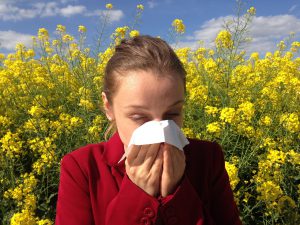
The Toxic, Stifling Fumes of Our Chemical World
This week, I’m taking a little break from my hormone and essential oils’ rampage for a very important and timely breather…natural tips for how to handle the season of spring sniffles!
Experts warn that the current increase of fluctuations in temperature and climate condition changes could result in greater numbers of pollen aggravations. This is not welcome news for many spring-time allergies suffers already red in the nose. (source, source)
It’s not only the natural environmental triggers that are springing up to cause more achoos. Living in a more polluted outside world has also been associated with intensified respiratory and health conditions. (source, source, source).
To compound this problem, the harmful substances found in consumer and household products are contributing to the increased body burden of our explosively chemicalized world inside people’s homes. These everyday products contain ingredients that cause havoc to the whole body and in the immune system are spurring up not only respiratory symptoms, but also endocrine disruption and many other chronic diseases. (source, source, source, source)
In a 2014 article published in Allergy, Asthma, and Immunology Research, the authors provided the proposed mechanisms behind the connection between environmental exposures and allergies. They related to an imbalance of T-helper cell function in response to these triggers:
The prevalence of asthma and allergic disease has increased worldwide over the last few decades. Many common environmental factors are associated with this increase. Several theories have been proposed to account for this trend, especially those concerning the impact of environmental toxicants. The development of the immune system, particularly in the prenatal period, has far-reaching consequences for health during early childhood, and throughout adult life. One underlying mechanism for the increased levels of allergic responses, secondary to exposure, appears to be an imbalance in the T-helper function caused by exposure to the toxicants. Exposure to environmental endocrine-disrupting chemicals can result in dramatic changes in cytokine production, the activity of the immune system, the overall Th1 and Th2 balance, and in mediators of type 1 hypersensitivity mediators, such as IgE. Passive exposure to tobacco smoke is a common risk factor for wheezing and asthma in children. People living in urban areas and close to roads with a high volume of traffic, and high levels of diesel exhaust fumes, have the highest exposure to environmental compounds, and these people are strongly linked with type 1 hypersensitivity disorders and enhanced Th2 responses. These data are consistent with epidemiological research that has consistently detected increased incidences of allergies and asthma in people living in these locations. During recent decades more than 100,000 new chemicals have been used in common consumer products and are released into the everyday environment. Therefore, in this review, we discuss the environmental effects on allergies of indoor and outside exposure. (source)
Other studies also provided support for allergies causing shifts in our defense system, but some cite evidence for different populations of immune cells, such as the TH17 cells. (source, source, source) Regardless of the nitty gritty details, the point is our body tries to do the right thing and protect us from a perceived invader(s), but over-responds or misreads the threat.

Cleaning Up Your Home and Health to Breathe Easier
Reducing your chemical burden with more earth-friendly and sustainable products is one way to provide a calmer immune system and lower the total toxic load on your body.
In previous posts, I shared how we can take positive action steps to clean up our homes and health and invited you to participate in our group’s six-month challenge. You can access the challenge by clicking on the links below:
Challenge 1: Safe Oral Care – Ditch Toxic Toothpaste
Challenge 2: “Cleaning up Your Home and Health in 6 Months” A Safer and Healthier Home with a Steal in Value!
Challenge 3: Keeping Our Bathroom a Safe Haven from “Beauty Products to Die For”
Challenge 4: Heading into Health for the Holidays- Immune Support for the Winter Season
Challenge 5: The Scent of a Healthy Home for Celebrating the Holidays with Essential Oils
Challenge 6: The Gratitude of Scent-sational Gifts
Essential oils in our household products and personal care regimes offer the dual benefit of providing immune and wellness support as they eliminate the need for using harsher and harmful products. When they are diffused in the air, they can help to support a cleaner environment, eliminate the need for toxic fragrances and “air fresheners”, and provide whole-body support at the same time. (HEPA filters and other air quality measures can be added for even more wellness benefits.)
Finally, implementing healthy lifestyle factors and addressing digestive and microbiome health, mitochondrial support, circulatory function, hormonal balance, and body structure alignment could all decrease achoos.
In a previous post, I discussed these connections and that essential oils can help with allergic symptoms that are already present. In my homepage blog, I offer more suggestions to start the sniffle season off with less nose blowing. Click here to read it.
Many blessings from my heart to yours!
This material is for information purposes only and is not intended to diagnose, treat, or prescribe for any illness. You should check with your doctor regarding implementing any new strategies into your wellness regime. These statements have not been evaluated by the FDA. (Affiliation link.)
Disclaimer: This information is applicable ONLY for therapeutic quality essential oils. This information DOES NOT apply to essential oils that have not been tested for purity and standardized constituents. There is no quality control in the United States, and oils labeled as “100% pure” need only to contain 5% of the actual oil. The rest of the bottle can be filled with fillers and sometimes toxic ingredients that can irritate the skin. The studies are not based solely on a specific brand of an essential oil, unless stated. Please read the full study for more information.
Thanks Pixabay and iStock purchases.



